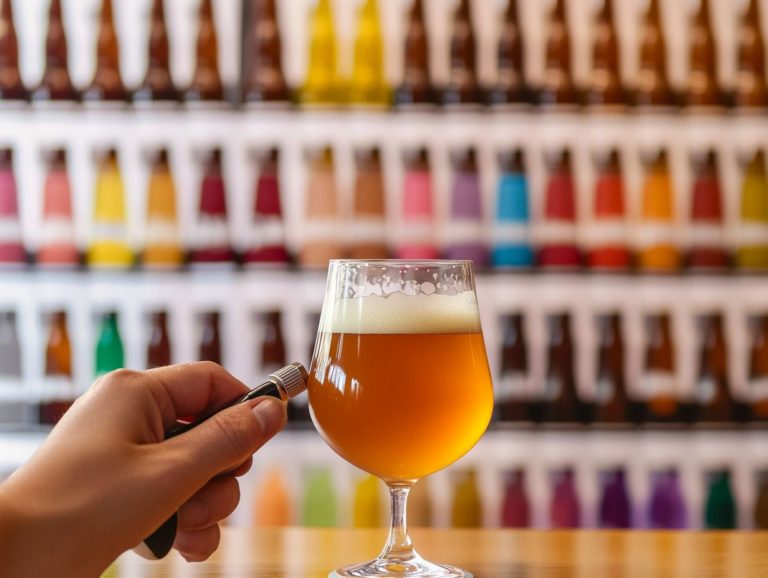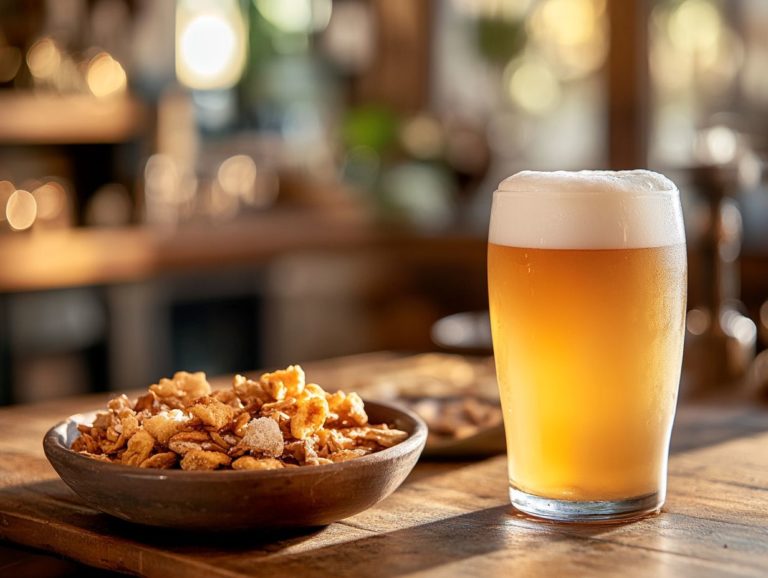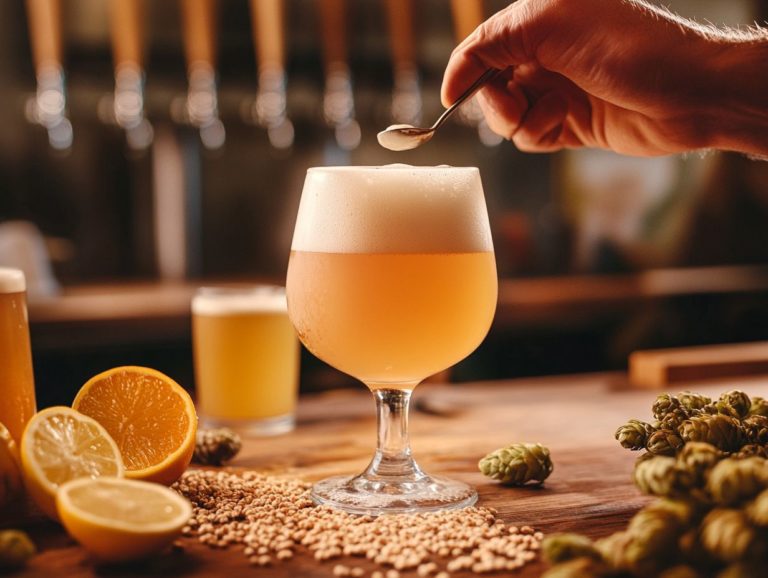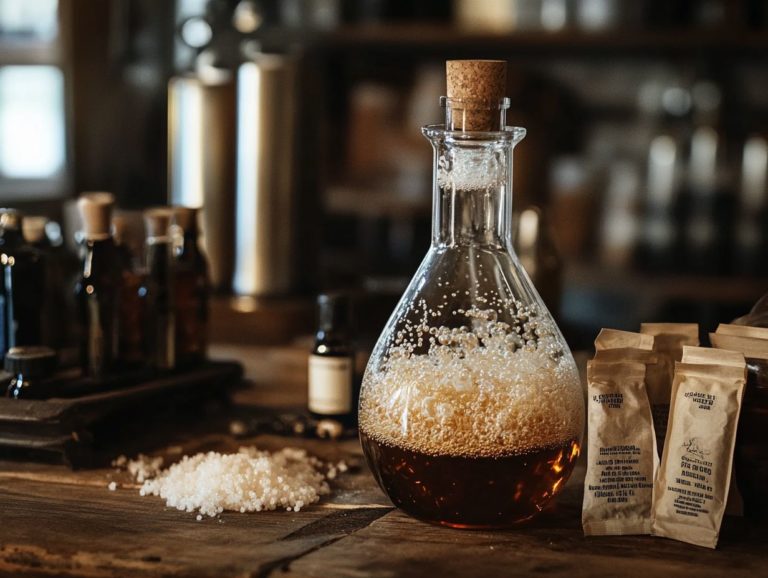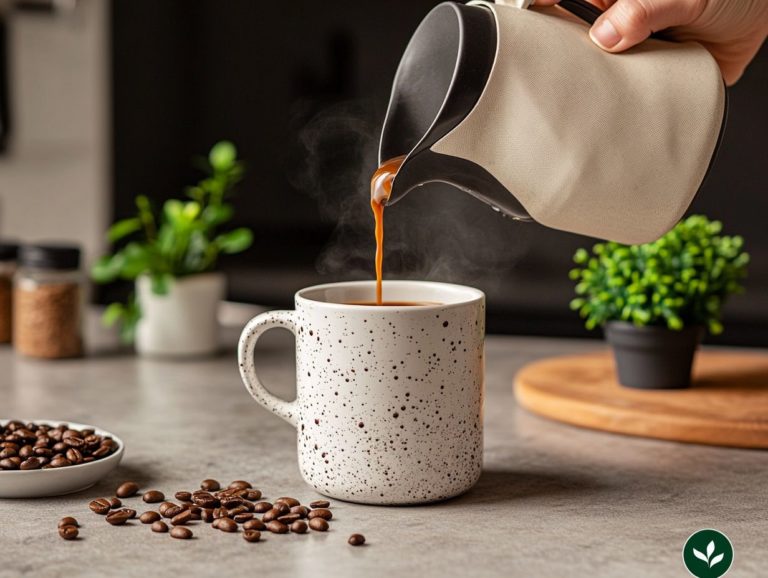5 Tips for Effective Beer Taste Testing
Beer tasting is an art form that transcends merely sipping your favorite brew; it invites you to engage your senses and savor the intricate flavors within the beer spectrum that each beer has to offer. Get ready to ignite your passion for this beloved beverage!
Whether you consider yourself a seasoned connoisseur or a curious newcomer, mastering the nuances of beer tasting can significantly elevate your experience.
Contents
- Essential Tips for Beer Tasting
- Key Takeaways:
- 1. Start with a Clean Palate
- 2. Use Proper Glassware
- 3. Observe the Color and Clarity of the Beer
- 4. Smell the Beer Before Tasting
- 5. Take Your Time and Savor Each Sip
- What Makes a Good Beer Taste Tester?
- How Can One Develop Their Palate for Beer Tasting?
- What Are the Common Mistakes to Avoid When Taste Testing Beer?
- How Can One Keep Track of Their Tasting Notes?
- What Are Some Tips for Pairing Beer with Food?
- Frequently Asked Questions
- What are 5 tips for effective beer taste testing?
- Can I taste multiple beers at once using these tips?
- Do I need to be a beer expert to do a taste testing?
- How can I keep track of the different beers I taste?
- Are there any specific foods I should pair with my beer taste testing?
- Should I only use these tips for beer taste testing at home?
Essential Tips for Beer Tasting
Here are five essential tips to help you taste beer like a pro, starting with the importance of a clean palate and delving into the critical role of aroma characteristics.
Key Takeaways:
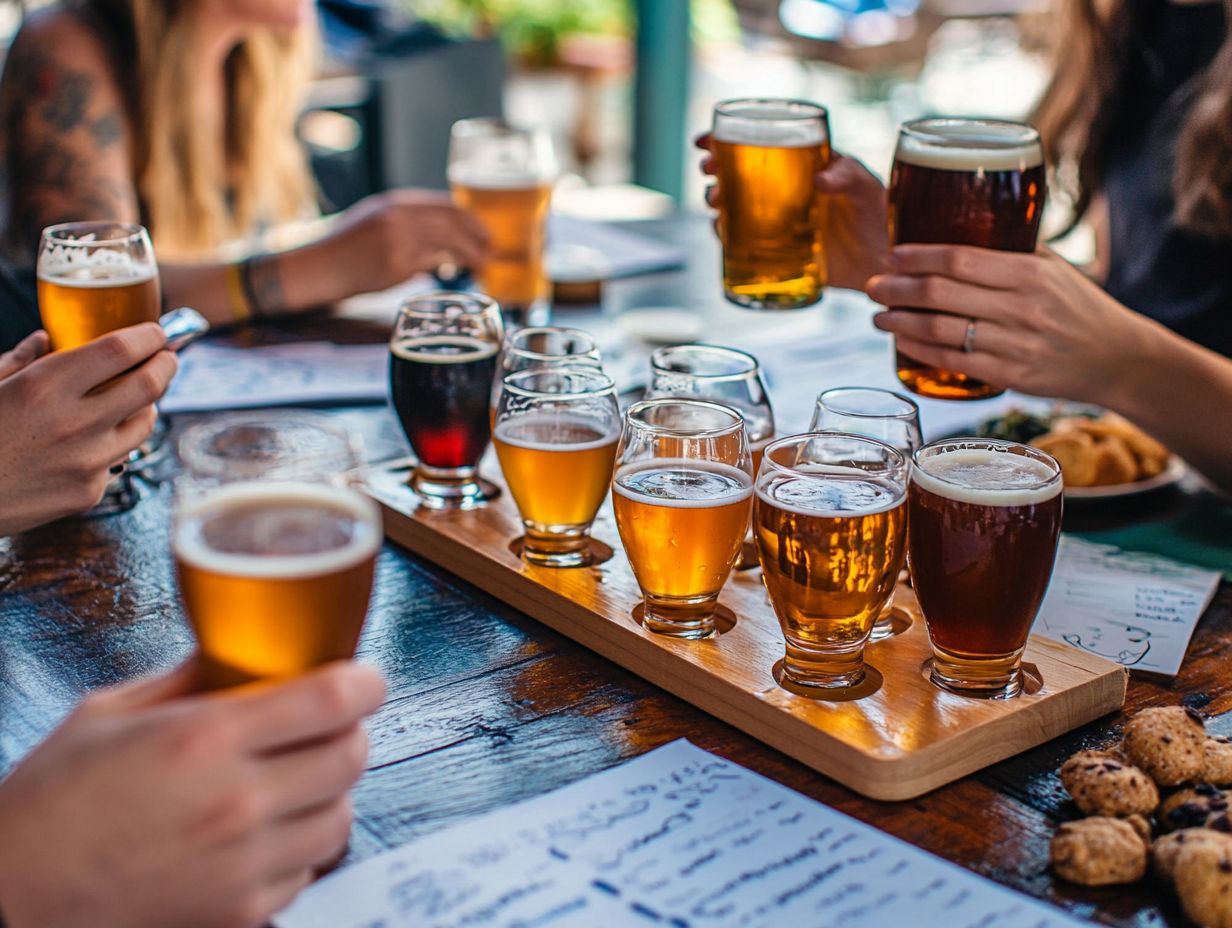
- Always start with a clean palate to ensure the true taste of the beer is not altered.
- Using proper glassware allows for better aroma and flavor appreciation.
- Observe the color and clarity of the beer as it can give hints about its flavor profile.
1. Start with a Clean Palate
Starting your beer tasting experience with a clean palate is essential for truly appreciating the diverse flavors and aromas present in craft beer. This approach allows each distinct beer style to shine during the tasting process.
A palate tainted by rich or spicy foods can easily obscure the subtle characteristics that make each beer unique, masking the nuances of hops, malts, and fermentation. That’s why creating an optimal tasting environment is key to achieving the most authentic experience.
Employing simple techniques like sipping water between tastings or nibbling on plain crackers can refresh your palate, enabling a clearer perception of the flavors in subsequent samples. By prioritizing this practice, you ll enhance your overall enjoyment and understanding of the craft, making each sip even more rewarding.
2. Use Proper Glassware
Using the right glassware for different beer styles can elevate your tasting experience, allowing you to fully appreciate the aroma characteristics and evaluate the beer’s flavor profile more effectively.
Choosing the right glass is crucial. Its shape and size profoundly influence how aromas are concentrated, enabling you to capture the entire essence of each brew. For example, a tulip glass for IPAs funnels those hoppy aromas directly to your nose, intensifying the sensory experience.
In contrast, a pint glass is perfect for lagers, showcasing the crisp and refreshing qualities of the beer beautifully. By paying attention to your glass selection, you amplify the flavors and enhance your overall enjoyment of the drinking experience.
3. Observe the Color and Clarity of the Beer
Observing the color and clarity of beer is a crucial step in your tasting journey, providing valuable insights into the beer’s style, brewing process, and even the flavor characteristics you might expect from the drink. Such observations lay the groundwork for informed judgments during the tasting process.
Take a dark stout, for example; its rich, opaque hue speaks volumes about the roasted malt features within, hinting at deep flavors like coffee or chocolate waiting to be discovered. On the flip side, a pale ale showcases a much lighter and more transparent appearance, suggesting a refreshing, citrusy palate that’s typically less robust.
Each beer category offers a distinct visual narrative from the amber tones of a Vienna lager that hint at a malty sweetness to the bright golden shades of a pilsner signaling crispness and floral notes. This sensory journey starts long before you take your first sip.
By understanding these visual cues, you can deepen your appreciation for the craftsmanship behind each brew, paving the way for a more informed and enjoyable tasting experience.
Now that you’ve learned the essential tips, gather your friends and embark on an exciting beer tasting adventure!
4. Smell the Beer Before Tasting
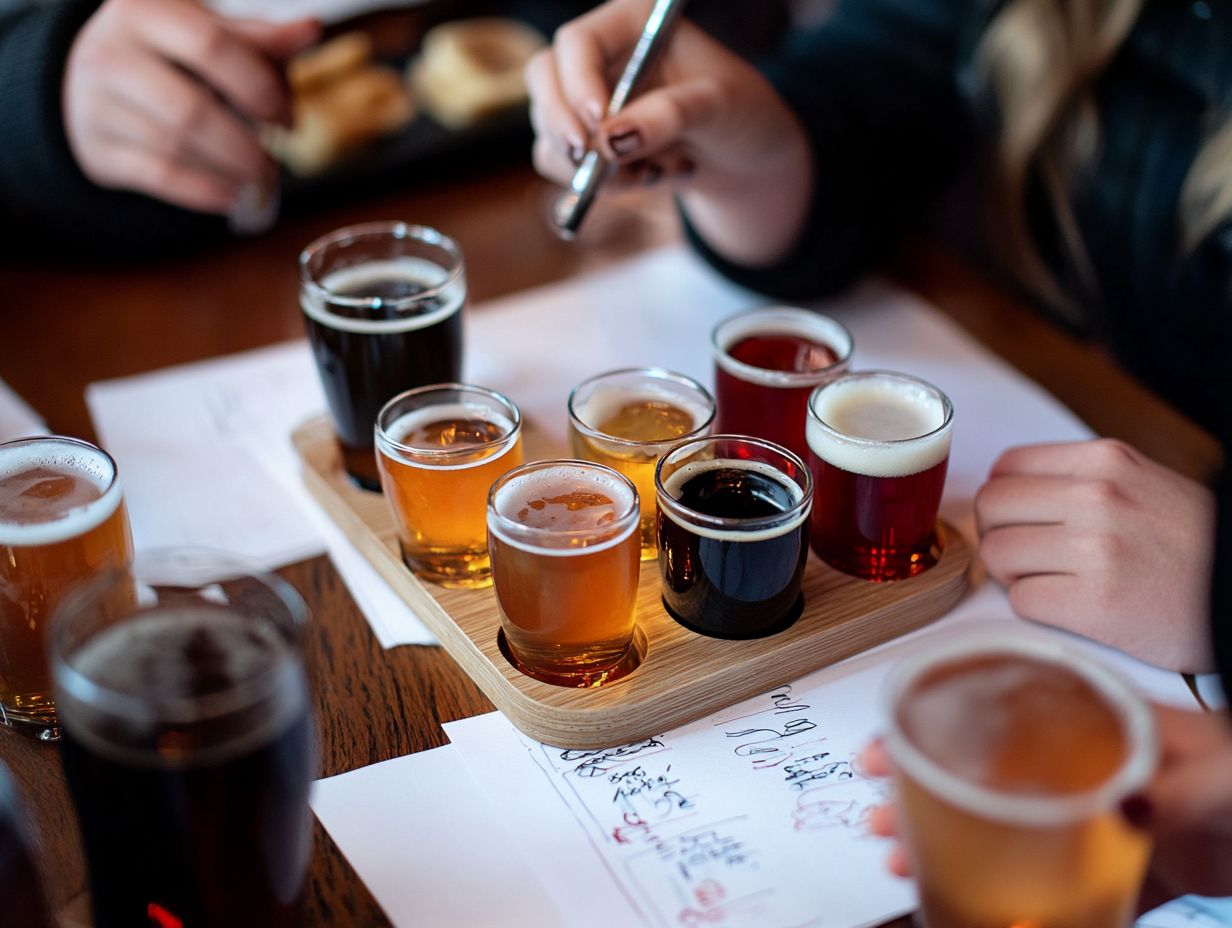
Smelling the beer before taking a sip is an essential part of the tasting experience. It allows you to fully appreciate the complex aroma characteristics that can offer valuable insights into the beer’s flavor profile and overall quality.
By utilizing the strength of the flavor wheel, you can identify a delightful array of scents ranging from fruity and floral to malty notes. Each contributes to your perception of the beer. Dive into the delightful world of aromas; this assessment not only enhances your tasting journey but also serves as a primary indicator of the beer’s craftsmanship and freshness.
When you take the time to engage with these aromatic elements, you may discover subtle nuances that could easily go unnoticed. Ultimately, this deepens your appreciation for each unique brew. Recognizing and articulating these scents is vital for any beer enthusiast, significantly elevating your overall tasting experience. The flavor wheel can be an invaluable tool for identifying the broad spectrum of beer aromas.
5. Take Your Time and Savor Each Sip
Taking your time and savoring each sip of beer is essential for a truly immersive flavor experience. This approach allows you to appreciate the intricate tasting characteristics, mouthfeel sensations, and the harmonious balance of flavors present in each unique brew.
Focus on the distinct aspects that make each beer special. You might consider employing techniques such as taking smaller sips, which can heighten your sensory exploration. Let the beer linger on your palate to give your taste buds the opportunity to fully grasp the complexity of its profile. Remember, draft beer experiences often offer the freshest representation of these flavors.
Pay close attention to the aroma as you bring the glass closer. The scent often unveils subtle nuances that enhance the overall tasting experience. The interplay of taste, smell, and texture not only elevates your enjoyment but also fosters a deeper appreciation for the artistry behind each brew.
What Makes a Good Beer Taste Tester?
Key Skills of a Good Beer Taste Tester
As a discerning beer taste tester, often dubbed a beer judge, you possess a profound understanding of various beer styles and flavor characteristics. Your expertise in the intricacies of the sensory evaluation process enables you to provide insightful opinions and constructive feedback during tastings at Thompson Island Brewing Co. or other brewpubs.
Your extensive knowledge goes beyond simply memorizing different beer types; it encompasses an appreciation of brewing techniques, the influence of ingredients, and the historical contexts that shape each brew. The ability to identify and articulate tasting notes is crucial, as you must effectively communicate the subtle differences in aroma, taste, mouthfeel, and aftertaste.
This skill enriches conversations among fellow enthusiasts and elevates the overall tasting experience for everyone involved. With a solid grounding in tasting skills, you are adept at discerning the nuances of each beer, ensuring that the tasting remains a thoughtfully curated affair.
This ultimately enhances the appreciation of craft beer within your community, fostering a deeper connection to the art of brewing. Such expertise is often recognized by organizations like the BJCP.
What Are the Key Elements to Look for in a Beer?
When evaluating a beer, you’ll want to focus on key elements like its flavor characteristics, aroma, mouthfeel, and overall balance. These components come together to create a rich tasting experience that highlights both the strengths and potential faults of the brew.
As you embark on this assessment process, consider taking detailed notes on the various flavor profiles that emerge. Pay attention to specific notes whether they be caramel, citrus, or floral undertones. It’s crucial to identify any off-flavors, as they can detract from your overall enjoyment and may signal issues during brewing or storage.
Understanding distinct beer styles allows you to compare and contrast different brews, as each style presents its own unique expectations. Side-by-side tastings can be particularly enlightening. By meticulously recording your tasting notes, you can track your personal preferences over time, leading to more informed and enjoyable selections in the future.
How Can One Develop Their Palate for Beer Tasting?
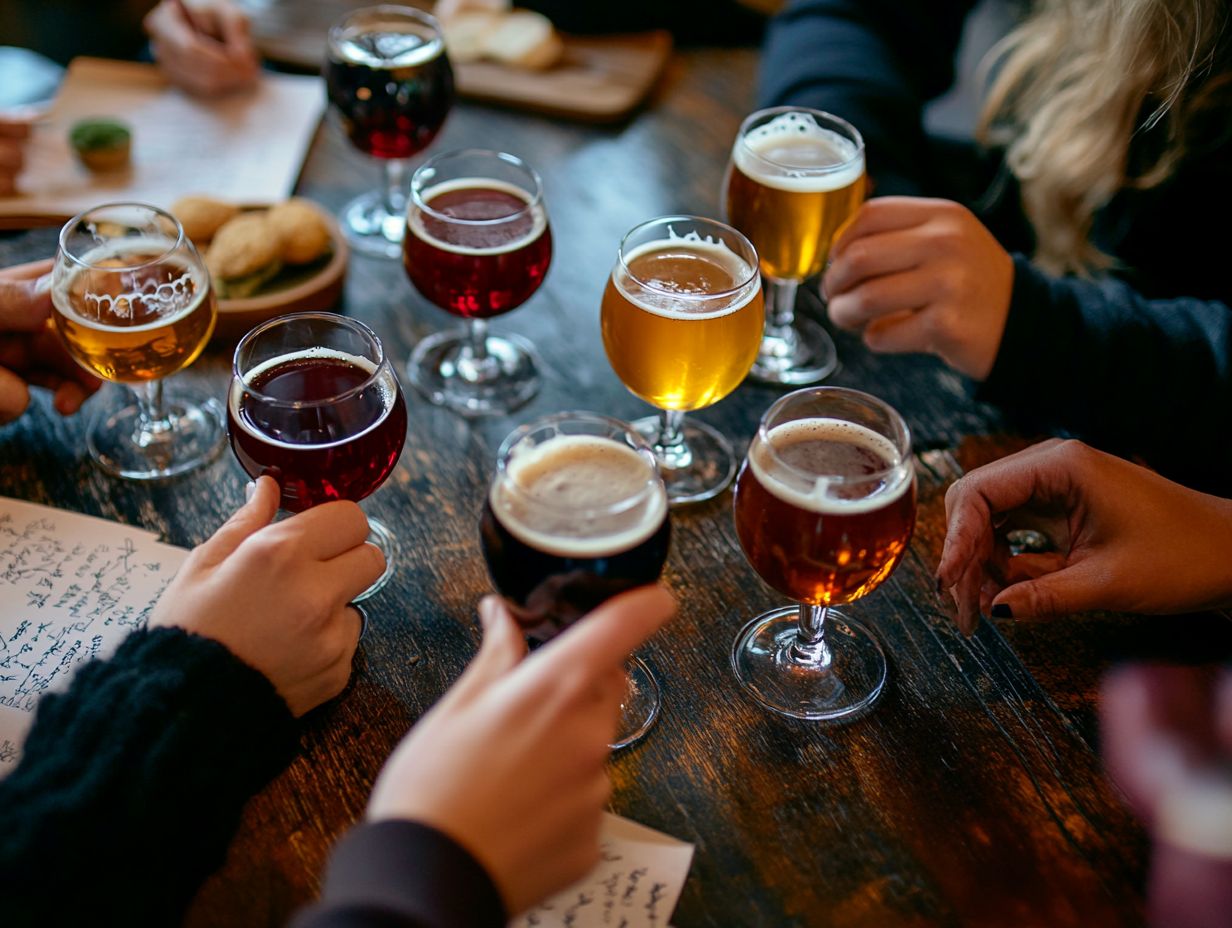
Developing your palate for beer tasting is an exciting journey. It involves regular tasting exercises and exploring various craft beer styles.
By immersing yourself in diverse tasting environments, you can discover unique beer characteristics. Guided tastings at local breweries offer valuable learning opportunities.
Consider keeping a journal to record your tasting notes. This practice helps you remember flavors and sharpens your tasting skills.
Consistent practice is essential. As you refine your palate, you’ll develop a richer appreciation for the world of beer.
What Are the Common Mistakes to Avoid When Taste Testing Beer?
When taste testing beer, avoid common pitfalls. Rushing, neglecting to cleanse your palate, and overlooking beer faults can diminish your experience.
To savor the complexities of brews, approach each tasting with patience. Don’t forget to compare similar styles and take detailed notes.
Elevate your experience by practicing off-flavor identification. Join guided tastings or use flavor kits for palate training.
Engaging in tasting exercises and using a flavor wheel can be beneficial. Exploring beer styles will deepen your understanding and enjoyment.
How Can One Keep Track of Their Tasting Notes?
Keeping track of tasting notes elevates your beer knowledge. It allows you to revisit evaluations and refine your sensory skills.
Adopt a note-taking routine using journals, mobile apps, or spreadsheets. Document sensory observations to deepen your understanding of brews.
Record tastes along with aroma, mouthfeel, and appearance. Draw comparisons between different beers.
As you note distinctive flavors, you create a reference guide. This helps identify preferences and discover new favorites.
What Are Some Tips for Pairing Beer with Food?
Beer pairing with food enhances your flavor experience. It does this by complementing or contrasting the beer’s unique characteristics with your dish.
Consider using a beer pairing guide to explore different combinations. By considering various pairing strategies, you can take your meal to new heights.
For example, matching lighter beer styles such as a crisp lager with seafood dishes creates a refreshing contrast. The beer’s carbonation effortlessly cuts through the richness of a buttery sauce.
Conversely, pairing a robust stout with rich chocolate desserts highlights contrasting flavors that harmonize beautifully. Paying attention to the weight and richness of both the beer and the food is key.
A hoppy IPA is bold enough to stand up to spicy dishes, while a smooth, creamy porter complements grilled meats magnificently. Understanding flavor characteristics will aid in these decisions.
With careful selection, the right beer can transform an ordinary meal into a memorable culinary experience. This transformation showcases the amazing balance of flavors that will elevate your dining experience!
Frequently Asked Questions
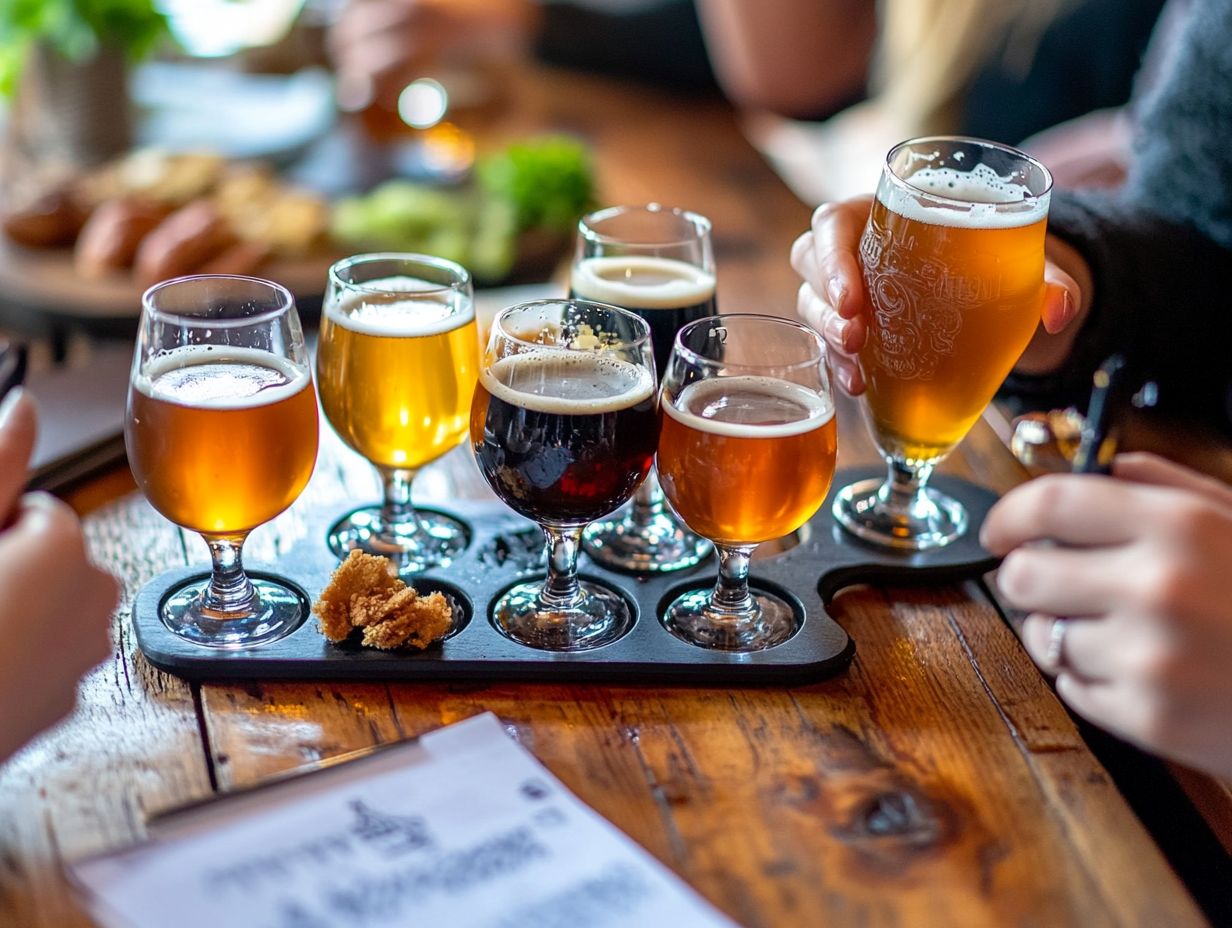
What are 5 tips for effective beer taste testing?
- Start with a clean taste. Before beginning your taste testing, refresh your taste buds with some water and crackers. This will help you fully taste and appreciate each beer.
- Use proper glassware. Different types of beer are best served in specific types of glasses. Make sure to use the appropriate glassware to enhance the flavor and aroma of each beer.
- Observe the appearance. Take a look at the beer’s color, clarity, and head formation. These characteristics can give you an idea of what to expect in terms of taste.
- Smell before sipping. A beer’s aroma can greatly impact its taste. Take a few deep sniffs before taking a sip to fully appreciate the different scents.
- Take small sips and savor. Don’t rush through your tasting. Take small sips and let the beer sit on your tongue for a few seconds to fully taste and appreciate the flavors.
Can I taste multiple beers at once using these tips?
Yes, you can use these tips to effectively taste multiple beers at once. Just make sure to refresh your taste buds in between each beer and take your time to fully taste and appreciate each one.
Consider doing side-by-side tastings for better beer evaluation.
Do I need to be a beer expert to do a taste testing?
No, you don’t need to be a beer expert to do a taste testing. These tips are designed for anyone looking to enhance their beer tasting experience, whether you’re a beginner or a seasoned beer drinker.
How can I keep track of the different beers I taste?
It’s helpful to keep a pen and paper handy to jot down notes about each beer you taste. This will help you remember which ones you liked and didn’t like, and what flavors and aromas stood out to you.
Are there any specific foods I should pair with my beer taste testing?
While there are no specific rules for pairing food with beer, it’s always a good idea to have some snacks on hand to refresh your taste buds in between tastings. Some popular choices include crackers, cheese, and nuts.
These snacks can enhance the beer tasting experience by providing a contrast or complement to the beer flavors.
What are your favorite beer and food pairings? Share your experiences in the comments below!
Should I only use these tips for beer taste testing at home?
You can use these tips for beer taste testing anywhere at home, in a brewery, or at a festival. These tips will enhance your beer tasting experience. Just make sure to follow the guidelines. Take your time to fully taste and appreciate each beer. This will help you better understand and enjoy beer.

